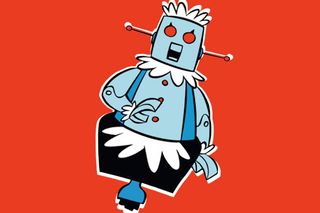
In The Near Future, Parents Will Have to Worry About Peer Pressure — From Robots
Maybe their influence will be used for good?

As if peer pressure wasn’t already a concern for parents, a new study suggests that the near future will bring another challenge to children’s good decision-making: peer pressure from humanoid robots.
Researchers looking into the effects of artificial intelligence, have found that children are significantly influenced by the presence of a humanoid robot when taking a basic test that asked them to identify which lines, among a series, were longest. The children, aged 7 to 9, scored more than 10% lower when taking the test alongside a humanoid robot, who made suggestions, than they achieved when taking the test alone. When they took the test in the presence of robots, 75% of the wrong answers children gave matched the robots’ suggestions.
The study also tested adults’ susceptibility to follow a robot’s lead, but found adults were largely able to resist the influence.
The findings, published in Science Robotics, suggest that, in the future, robots can be used to influence society. Unfortunately, whether these effects of artificial intelligence are positive or negative is part of a long-running and yet-to-be-decided debate. A best-case scenario, envisioned by the researchers, is the use of humanoid robots as education assistants or child therapists.
“People often follow the opinions of others and we’ve known for a long time that it is hard to resist taking over views and opinions of people around us. We know this as conformity. But as robots will soon be found in the home and the workplace, we were wondering if people would conform to robots,” said study author Tony Belpaeme, a professor of robotics at the University of Plymouth, UK. “Which does pose the question: what if robots were to suggest, for example, what products to buy or what to think?”
Soon probably means sooner than we think. Many of us, including our kids, are becoming accustomed to AI in our homes in the form of Amazon’s Alexa or Google Home. According to some estimates, by 2020, one in 10 households in the US will include robots. Even if that means 1 in 1000 elsewhere, that’s still an astonishingly quick uptake. It’s unclear if these robots will be humanoid, and the current study did not examine the influence of non-humanoid robots. But since the disembodied Alexa is already influencing children’s manners, it seems safe to assume it’s merely a matter of degrees and ways in which children will be influenced. (In any case, extremely human-like robots aren’t that far off either.)
The researchers recognize this, and hope their findings can start a conversation about how children should be allowed to interact with artificial intelligence.
“A discussion is required about whether protective measures, such as a regulatory framework, should be in place that minimise the risk to children during social child-robot interaction and what form they might take so as not to adversely affect the promising development of the field,” the researchers said.
Related


Parental Controls Don’t Keep Kids from Sexually Explicit Online Content
